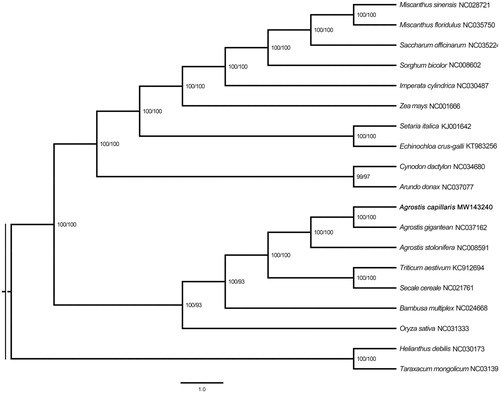Abstract
Agrostis capillaris is a cool-season turf grass species that is found worldwide in temperate countries, and a good Pb phytostabilizer. In this study, the entire chloroplast genome sequence of A. capillaris was determined by Illumina sequencing. The complete chloroplast genome was circular and composed of 136,396 bp nucleotides with a GC content of about 38.5%. There were a large single-copy region (LSC, 81,659bp), a small single-copy region (SSC, 12,593bp), and a pair of reverse repeat regions (IRs, 42,144bp) in the chloroplast genome. In total, the A. capillaris chloroplast genome contained 144 genes, including 96 protein-coding genes, 40 tRNA genes, and 8 rRNA genes. Phylogenetic analysis revealed that A. capillaris was closely related to A. gigantean. The sequence data of A. capillaris chloroplast genome could provide useful genetic information for the studies on phylogenetic and evolutionary of Agrostidinae.
Agrostis capillaris is classified as a cool-season turf grass species in the Gramineae family, and has been used for landscaping widespread. This grass is found worldwide in temperate countries (Saarela et al. Citation2017). A. capillaris can tolerate high concentrations of Pb and is a good Pb phytostabilizer (Lebrun et al. Citation2021). And Pb concentrations in Agrostis plants are higher in the roots compared to the aerial parts (Rodríguez-Seijo et al. Citation2016). The Pb phytostabilization capacity of A. capillaris has be revealed through the considerable accumulation of Pb in roots and the presence of secondary mineral in the soil (Dahmani-Muller et al. Citation2000). This secondary mineral interacts with Pb and reduces its mobility, eliminating it from the metabolisms of plants (Patricia and Fernandez-Cirelli Citation2008). However, there are few reports about the chloroplast genome analysis of A. capillaris. In this study, we reported the complete chloroplast genome of A. capillaris, which will provide useful genetic information for the studies on phylogenetic and evolutionary of Agrostidinae.
Fresh leaves of A. capillaris were collected from three different plantlets at the Botanical Garden of Northwest University (34°25'N, 108°93'E). Those leaves were stored at the Northwest University herbarium (Yuwei Zhao, [email protected]) under the voucher number 2021102. The total genomic DNA was isolated from those leaves by a modified CTAB method (Doyle Citation1987). The specific modification was that five volumes (about 500 μL) ice-cold absolute ethanol were used to precipitate DNA overnight at −20 °C. The DNA samples were deposited at −80 °C at the Provincial Key Laboratory of Biotechnology of Shaanxi Province, Xi’an, China. The complete chloroplast genome of A. capillaris was sequenced by Illumina NovaSeq PE150 System at Beijing Biomarker Technologies Co., Ltd., and assembled through GetOrganelle program (Jin et al. Citation2018) with reference to Oryza sativa chloroplast genome (NC_031333). The complete chloroplast genome of A. capillaris was annotated in Geneious ver. 8.0.2, and then submitted to GenBank (Accession No. MW143240).
The A. capillaris circular chloroplast genome was 136,396 bp and contained a large single-copy region (LSC) of 81,659 bp, a small single-copy region (SSC) of 12,593 bp and a pair of reverse repeat regions (IRs) of 42,144 bp.
There were 144 genes in the chloroplast genome, including 96 protein-coding genes, 40 tRNA genes, and 8 rRNA genes. The overall GC content of the chloroplast genome was about 38.5%.
To determine the phylogenetic position of A. capillaris within the family Gramineae, the complete chloroplast genome sequencs of 16 Gramineae species and two Asteraceae species were aligned with MAFFT version 7.450 (Katoh and Standley Citation2013) and then visualized and manually adjusted using BioEdit (Hall Citation1999). A maximum likelihood (ML) tree was performed using MEGA 7.0 (Sudhir et al. Citation2016) with 1000 bootstrap replicates. The result indicated that A. capillaris was sister to A. gigantean ().
Disclosure statement
No potential conflict of interest was reported by the author(s).
Data availability statement
The genome sequence data that support the findings of this study are openly available in GenBank of NCBI at (https://www.ncbi.nlm.nih.gov/) under the accession number: MW143240. The associated BioProject, SRA, and Bio-Sample numbers are PRJNA698087, SRR13617003 and SAMN17705311, respectively.
Additional information
Funding
References
- Dahmani-Muller H, Oort FV, Gélie B, Balabane M. 2000. Strategies of heavy metal uptake by three plant species growing near a metal smelter. Environ Pollut. 109(2):231–238.
- Doyle JJ, Doyle JL. 1987. A rapid DNA isolation procedure for small quantities of fresh leaf tissue. Phytochem Bull. 19:11–15.
- Hall TA. 1999. BioEdit: a user-friendly biological sequence alignment editor and analysis program for Windows 95/98/NT. Nucl Acids Symp Ser. 41(41):95–98.
- Jin J-J, Yu W-B, Yang J-B, Song Y, Yi T-S, Li D-Z. 2018. GetOrganelle: a simple and fast pipeline for de novo assembly of a complete circular chloroplast genome using genome skimming data. BioRxiv: 256479.
- Lebrun M, Nandillon R, Miard F, Forestier LL, Morabito D, Bourgerie S. 2021. Effects of biochar, ochre and manure amendments associated with a metallicolous ecotype of Agrostis capillaris on As and Pb stabilization of a former mine technosol. Environ Geochem Health. 43(4):1491–1505.
- Patricia M, Fernandez-Cirelli A. 2008. Phosphates for Pb immobilization in soils: a review. Environ Chem Lett. 6(3):121–133.
- Rodríguez-Seijo A, Lago-Vila M, Andrade ML, Vega FA. 2016. Pb pollution in soils from a trap shooting range and the phytoremediation ability of Agrostis capillaris L. Environ Sci Pollut Res Int. 23(2):1312–1323.
- Saarela JM, Bull RD, Paradis MJ, Ebata SN, Peterson PM, Soreng RJ, Paszko B. 2017. Molecular phylogenetics of cool-season grasses in the subtribes Agrostidinae, Anthoxanthinae, Aveninae, Brizinae, Calothecinae, Koeleriinae and Phalaridinae (Poaceae, Pooideae, Poeae, Poeae chloroplast group 1). PhytoKeys. 87:1–139.
- Katoh K, Standley DM. 2013. MAFFT multiple sequence alignment software version 7: improvements in performance and usability. Mol Biol Evol. 30(4):772–780.
- Sudhir K, Glen S, Koichiro T. 2016. MEGA7: molecular evolutionary genetics analysis version 7.0 for bigger datasets. Mol Biol Evol. 33(7):1870.

